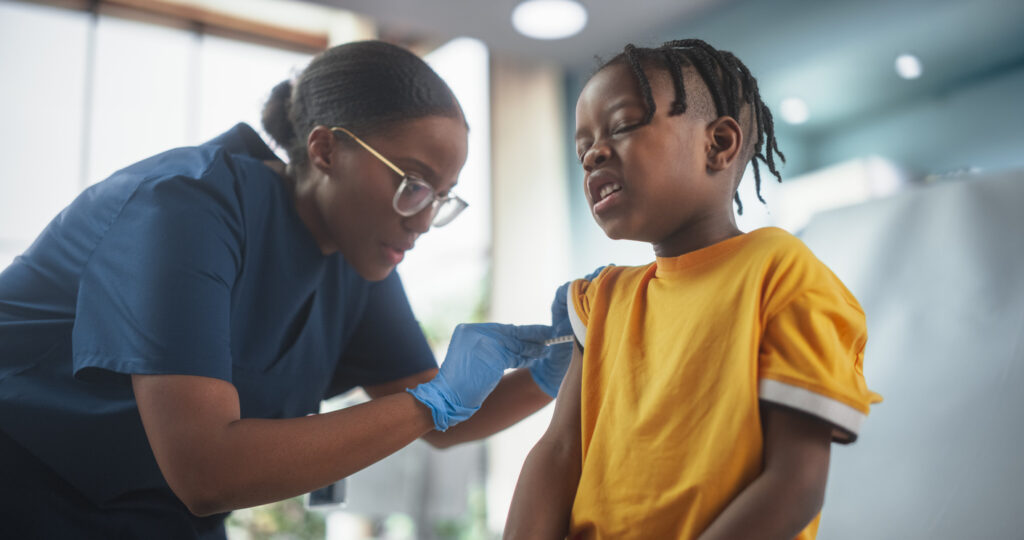By Lynna J. Yang and Peter Lio, MD
Pediatric patients are often unable to tolerate in-office procedures due to the pain and anxiety, which, in extreme cases, can necessitate the use of general anesthesia for minor procedures. The repercussions of unmanaged pain can also have potentially long-term detrimental effects leading to the development of medical-related fears and trauma. These medical experiences increase the risk of adverse psychological outcomes, including anxiety, depression, and behavioral problems.1 There is growing interest in exploring alternative approaches to pain management. While distraction techniques have long demonstrated significant efficacy, virtual reality (VR) distraction has recently emerged as a cutting-edge and promising intervention for alleviating pain and distress during medical procedures. Herein, we review the relevant literature on several new VR, mixed reality, and augmented reality technologies applicable to dermatology.
Distraction Techniques for Medical Procedures
In addition to or in lieu of pharmacologic pain relievers, various psychological approaches have demonstrated effectiveness in alleviating pain and discomfort, including cognitive-behavioral therapy, hypnosis, and distraction.2 Distraction techniques encompass an array of modalities tailored to engage and captivate the attention of patients to divert from the stressors of medical interventions. These techniques include visual distractions like interactive screens, colorful imagery, or engaging videos, and auditory techniques, including music or guided relaxation, tactile distractions, such as stress balls or textured surfaces, plus more. A systematic review found a significant reduction in pain and distress in needle-related procedures using various distraction techniques, including visual, auditory, and tactile distractions.3 Remarkably, one randomized controlled trial studying preoperative anxiety in children undergoing outpatient surgery found that the groups receiving parental presence and oral midazolam exhibited significant increases in anxiety, whereas the group receiving a handheld video game did not.4 These studies and many others highlight the power of distraction techniques in improving patient well-being during medical procedures. Among the variety of distraction techniques, there has been recent interest in VR as a particularly immersive and innovative distraction technique.
Virtual Reality: A New Distraction Technique
With the advancement of technology, VR has emerged as a promising distraction technique in the realm of medical procedures. VR immerses the user in a virtual environment—both audio and visual—completely blocking out the people, the equipment, and the procedure and diverting their attention from the pain signals coming from the real world.5 VR distraction has been found to be effective in both acute and chronic pain across a variety of medical specialties and conditions.6 (See figure 1.)
Figure 1: AI-generated image of a child using a VR headset in a medical office during a procedure.

Image attribution: Dr. Lio generated this image in part with GPT-3, OpenAI’s large-scale language-generation model. Upon generating draft language, the author reviewed, edited, and revised the language to their own liking and takes ultimate responsibility for the content of this publication.
VR has also shown to be effective in pediatric patients, for whom procedures can be particularly distressing. A systematic review and meta-analysis found that VR intervention significantly reduced pain, anxiety, and fear in pediatric patients undergoing puncture-related procedures.7 The study also highlighted the superiority of VR compared to regular distraction methods in reducing self-reported pain. However, the efficacy of VR compared to other visual distraction methods is debated. For instance, one randomized controlled trial indicated that while both VR and watching a video displayed on a computer screen reduced anxiety and pain during buccal infiltration anesthesia in pediatric patients, there was no added benefit of VR over a regular video.8Nevertheless, there seems to be overall consensus that VR has the potential to be an effective intervention for managing procedural pain and anxiety, particularly in the pediatric population who have a propensity for heightened distress.
Applications to Dermatology
Medical procedures are an important diagnostic and therapeutic aspect of dermatology, presenting a compelling opportunity for the integration of VR distraction. Research findings indicate the potential benefit of utilizing VR in various dermatological scenarios. One study demonstrated that use of VR in adult patients undergoing Mohs surgery produced significant improvement in patient-reported anxiety and overall satisfaction but not pain.9 Another study reported that VR decreased procedure-related anxiety and pain in adults receiving scalp injections.10 In children, a study compared the effectiveness of VR and noise-canceling headphones in reducing pain and anxiety during dermatologic procedures, including lasers, injections, excisions, biopsies, incision and drainages, and cryotherapy. The study found that both VR and noise-canceling headphones improved patient-reported anxiety but not pain, and did not demonstrate that one technique was superior to the other.11 These studies highlight that VR may be an option to improve patient experiences during dermatological procedures, but further studies are necessary to better understand the efficacy of VR in comparison to other distraction methods and to optimize the efficacy of VR. (See table 1.)
Table 1: Summary of studies on VR in dermatology
| Study | Sample | Study design | Interventions | Summary of key findings |
| Higgins et al. 2019 | 109 patients undergoing Mohs surgery | Randomized | Group 1: Google Daydream headset with videos of Joshua Tree National Park, 1962 moon landing, and equestrian dressage
Group 2: Vive VR headset with TheBlu (underwater experience observing sea creatures) and Tilt Brush (3-dimensional painting experience) | VR reduced anxiety and improved patient satisfaction |
| Jaquez et al. 2023 | 109 pediatric patients (aged 5-18) undergoing procedures including excimer laser, laser for hair removal or vascular lesions, injections, excision, biopsy, incision and drainage, and cryotherapy | Randomized controlled | Group 1: Control (no VR)
Group 2: Noise-canceling headphones
Group 3: KindVR headset | VR and noise-canceling headphones reduced anxiety similarly |
| Pathoulas et al. 2022 | 18 patients receiving scalp platelet-rich plasma injections | Randomized controlled crossover | Group 1: Control (no VR)
Group 2: Single-use disposable VR device with simulated nighttime flight through Tokyo, Japan | VR reduced anxiety and pain |
Conclusion
The evolving landscape of VR applications presents a promising avenue for enhancing patient experiences during medical procedures in dermatology and pediatric dermatology. The advent of new, more powerful VR hardware from companies like Meta and Apple suggests that VR may become more available and perhaps even more effective for pain and anxiety management in the near future. VR distraction has the potential to support a variety of pediatric dermatologic procedures, such as injections, biopsies, laser treatments, and venipuncture. In the long term, it may reduce the need for sedation for minor procedures that can be done in the office and improve psychological outcomes in pediatric patients who require procedures that could otherwise be traumatizing.
While much of the literature on VR in acute management for procedures is encouraging, we cannot yet say for certain that VR is superior to other distraction techniques. Furthermore, the effectiveness of VR may vary based on several factors, such as the setting in which it is used (for example, home, clinic, inpatient, or the operating room), the specific procedure involved (such as the duration, invasiveness, complexity, and risk-benefit ratio of the procedure), the timing and type of VR application (pre-, during, or post-procedure and how interactive and engaging the specific application is), and patient-related factors (including age, sociocultural background, prior experiences with medical procedures, etc.). Further research is also needed to evaluate the cost-effectiveness of VR use in healthcare settings, especially compared to other cheaper and more readily available distraction techniques. Addressing these gaps in knowledge will be crucial for refining the implementation of VR in dermatologic procedures, optimizing its benefits, and ensuring its integration aligns with the diverse needs of pediatric patients.
References:
- Lerwick JL. Minimizing pediatric healthcare-induced anxiety and trauma. World J Clin Pediatr. 2016;5(2):143-150
- Malloy KM, Milling LS. The effectiveness of virtual reality distraction for pain reduction: a systematic review. Clin Psychol Rev. 2010;30(8):1011-1018.
- Cho M, Choi M. Effect of distraction intervention for needle-related pain and distress in children: a systematic review and meta-analysis. Int J Environ Res Public Health. 2021;18(17).
https://doi.org/10.3390/ijerph18179159. - Patel A, Schieble T, Davidson M, et al. Distraction with a hand-held video game reduces pediatric preoperative anxiety. Paediatr Anaesth. 2006;16(10):1019-1027.
- Hoffman HG, Meyer WJ, Drever SA, et al. Virtual reality distraction to help control acute pain during medical procedures. In: Rizzo A, Bouchard S, eds. Virtual Reality for Psychological and Neurocognitive Interventions. New York, NY: Springer New York; 2019:195-208.
- Kenney MP, Milling LS. The effectiveness of virtual reality distraction for reducing pain: a meta-analysis. Psychol Conscious: Theory Res Pract. 2016;3(3):199-210.
- Yan G, Xu Y, Liu N, Fan L. Effectiveness of virtual reality intervention on reducing the pain, anxiety, and fear of needle-related procedures in paediatric patients: a systematic review and meta-analysis. J Adv Nurs. 2023;79(1):15-30.
- Felemban OM, Alshamrani RM, Aljeddawi DH, et al. Effect of virtual reality distraction on pain and anxiety during infiltration anesthesia in pediatric patients: a randomized clinical trial. BMC Oral Health. 2021;21(1):321.
- Higgins S, Feinstein S, Hawkins M, et al. Virtual reality to improve the experience of the Mohs patient: a prospective interventional study. Dermatol Surg. 2019;45(8):1009-1018.
- Pathoulas JT, Flanagan KE, Walker CJ, et al. Use of virtual reality during scalp injections: a randomized interventional crossover study. J Am Acad Dermatol. 2022;87(5):1091-1093.
- Jaquez SD, Haller CN, England ME, et al. Virtual reality and noise canceling headphone distraction during pediatric dermatologic procedures. Pediatr Dermatol. 2023;40(6):1161-1163.
About the Authors

Lynna J. Yang is a fourth-year medical student at Northwestern University Feinberg School of Medicine in Chicago, IL
Disclosures: None

Peter A. Lio, MD, is a Clinical Assistant Professor of Dermatology and Pediatrics at Northwestern University Feinberg School of Medicine and a partner at Medical Dermatology Associates of Chicago in Chicago, IL.
Disclosures: Dr. Lio reports research grants/funding from AbbVie, AOBiome, Eczema Foundation, and National Eczema Association; is on the speakers bureaus of AbbVie, Eli Lilly, Galderma, Hyphens Pharma, Incyte, La Roche-Posay/L’Oreal, MyOR Diagnostics, ParentMD, Pfizer, Pierre-Fabre Dermatologie, Regeneron/Sanofi Genzyme; reports consulting/advisory boards for AbbVie, Almirall, Amyris, Arbonne, Arcutis, ASLAN, Boston Skin Science, Bristol-Myers Squibb, Burt’s Bees, Castle Biosciences, Codex Labs, Concerto Biosci, Dermavant, DermVeda, Eli Lilly, Galderma, IntraDerm, Janssen, Johnson & Johnson, Kaleido Biosci, Kimberly Clark, LEO Pharma, Lipidor, L’Oreal, Menlo Therapeutics, Merck, Micreos, MyOR Diagnostics, Regeneron/Sanofi Genzyme, Skinfix, Sonica, Theraplex, UCB, Unilever, Verrica, Yobee Care; and has stock options with: Micreos, Modernizing Medicine, and Yobee Care. In addition, Dr. Lio has a patent pending for a Theraplex product with royalties paid and is a board member and scientific advisory committee member of the National Eczema Association.


